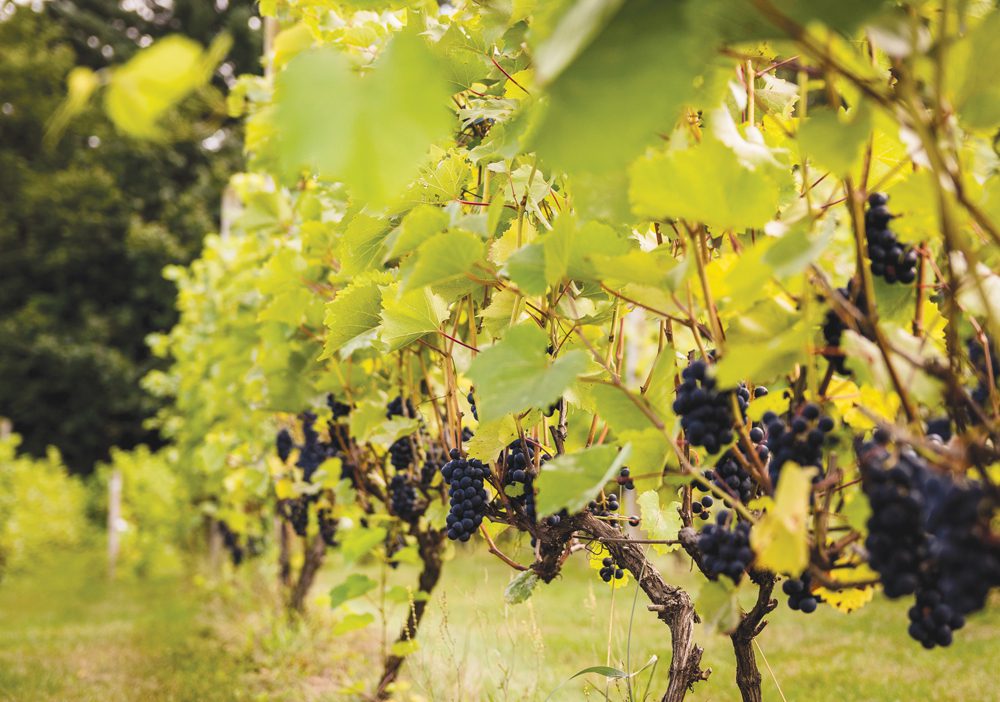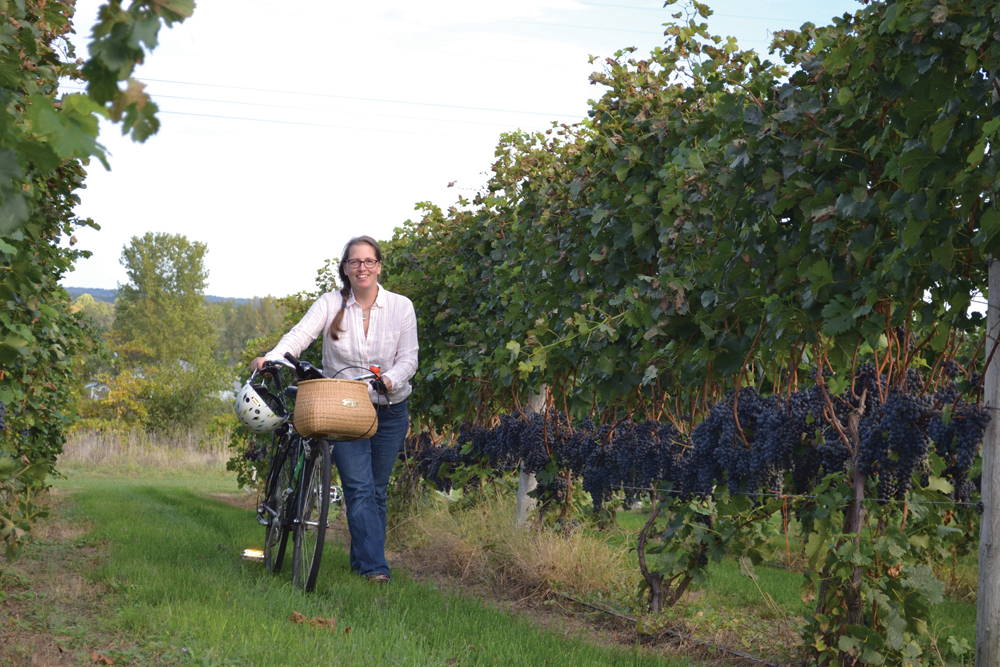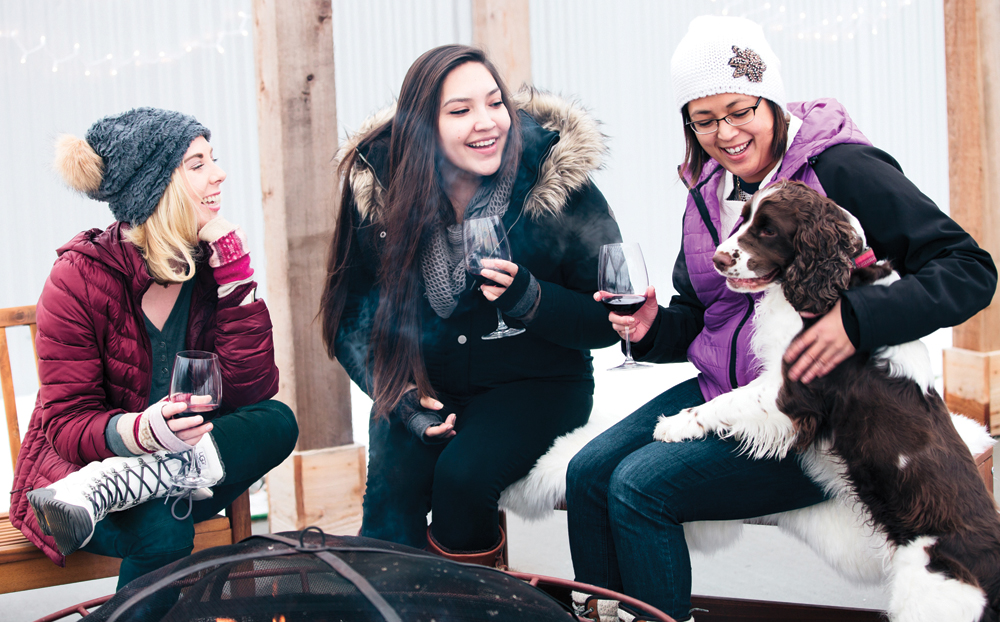

Innovative partnerships. An emphasis on luxury and VIP experiences. Investments in equipment, unique facilities and lifestyle centers. No, those aren’t descriptions of retail, automotive or upscale health care industries. They’re about Michigan’s longstanding, yet constantly evolving wine business.
Michigan wines and wineries have matured like … well, a fine wine. What started as a cottage industry with less than a dozen players has blossomed in recent years into a well-established and organized group of orchards, wineries and tasting rooms. New cooperative initiatives are joining the state’s venerable wine council to support the more than 130 wineries and wine-related businesses.
“We had no choice – we had to innovate,” says Jay Briggs, winemaker for 45 North Vineyard and Winery in Leelanau County. “Over the past 10 years, there’s been this remarkable jump in wine quality because we’re learning how the grapes react to our climate, how people grow them, how they react in the cellar. We’re really taking it pretty seriously. The rest of the nation is starting to come around (to Michigan’s potential).”
The state’s wineries range in size, age, and investments, but they have several things in common. They all have put their time, money and talents into upgrading Michigan’s sales and production. They have added the latest in equipment. They have established partnerships to bring new tours, trails and other tourism options to their regions. They’ve also put serious money into training, establishing strong cultures and hiring the right employees to boost not only their reputations, but that of the state as a whole as a wine destination.
 Cities from Baroda to Grand Rapids to Ferndale are now working side by side with well-known names such as Jackson, Traverse City, and the Leelanau Peninsula. That is part of the reason why you see newcomers in places like Tecumseh finding willing mentors in Paw Paw, South Haven and across the state.
Cities from Baroda to Grand Rapids to Ferndale are now working side by side with well-known names such as Jackson, Traverse City, and the Leelanau Peninsula. That is part of the reason why you see newcomers in places like Tecumseh finding willing mentors in Paw Paw, South Haven and across the state.
People’s enjoyment of wine and the desire to learn more about this complex drink also has spurred a variety of businesses and related services. Longtime tourism establishments from Traverse City to Brooklyn to Detroit offer “winery weekends,” yoga retreats and whimsical harvest dinners that encourage wine-inspired getaways at their hotels, resorts and vacation rentals of all sizes.
In addition to the vineyards, the industry is getting an extra boost as the food and beverage industry emphasizes Michigan wines. Restaurants such as the Andiamo Group are hiring expert sommeliers to ensure they have the best pairing and are setting wine trends. Then there are new wine shops and bars, including Vertical, The Royce Detroit and the House of Pure Vin, opening in a variety of communities, elevating a simple tasting into a date-night extravaganza.
And it’s not just the mighty grape that’s getting people’s attention. Hard apple cider, fruit-infused alcoholic beverages, and mead—basically wine made from fermented honey—are gaining fans across the state. These boutique establishments are winning industry awards, creating agri-tourism destinations and sponsoring events in hopes of establishing their fair share of the adult-beverage marketplace.
It’s extraordinary to see how Michigan’s wineries have gone from small concerns to now enjoying the fruits of those early labors, said Karel Bush, executive director of the Michigan Grape and Wine Industry Council in Lansing.
Founded in 1985 with about 12 members, the Michigan Grape and Wine Industry Council is part of the Michigan Department of Agriculture & Rural Development. Its purpose is to help provide research, education and the promotion of the Michigan grape and wine industry, to stimulate the state’s economy and sustainable agriculture industry.
“The potential for growth is still here,” Bush said. “We’re seeing new wineries every year. For about a decade, it was unbelievable. We had eight to 10 new openings per year. It’s slowed down now and it is more like two to four annually. But that’s still growth and there’s still room for more.”
Traverse City, an area known for wineries, is a good example of how even a region that has a fair number of wine-related businesses can keep adding newcomers, Bush noted.
“You hear people asking whether we’ve reached saturation in some areas, such as Traverse City. But I don’t see that happening for any time in our state, even in those regions where it seems like there is already a good number,” Bush said. “If you look at Napa or Sonoma (in California), how many are there? They still have some very successful wineries opening. We’re a long way from hitting that saturation point.”
Bush says those in the Council are excited about many changes within the state’s grape and wine industry as a whole. One significant change is the addition of the Michigan Wine Collaborative, a not-for-profit organization that formed in August 2016 to support wineries, growers and other businesses connected to the grape and wine industry.
The Michigan Wine Collaborative is working in conjunction with Michigan’s Grape and Wine Industry Council to ensure the state has the funding for research, education, marketing and legislative action – just like other states do, explained David Miller, the group’s president and owner of the White Pine Winery, located in St. Joseph. While the two groups may seem like they do the same thing or could be in conflict, they work in conjunction with one another and support each other.
“Our goal is to support the interests of our industry from vineyard to bottle and onto the consumers’ tables,” Miller said. “The next phase of growth for our industry will require both private and public funds and the efforts of many to set the stage for what is to come.”
Having resources like this, along with mentors, helped retired firefighter Mike Wells open his first winery in Tecumseh. Black Fire Winery is a labor of love, farming, and agriculture, Wells said. It also showed him that there is a brotherhood within Michigan’s wine industry that helps others, in hopes of helping everyone.
“When I decided I wanted to open a winery, I visited a lot of places and attended a lot of meetings. Once the (other winemakers) realize you’re serious, they’ll help you,” said Wells, who claims to be the first African American winemaker in the state.
Wells started making wine as a teen living in Detroit, after finding some wild grape vines in his family’s backyard. Fast forward to 2002, and Wells announced to his wife and accountant that he was going to start a full-time wine business. He attended wine-making classes, learned how to grow grapes and make wine commercially, seeking advice from others across the state until he was ready to establish Black Fire and open its tasting room in 2016.

“There’s a lot of things that you learn in school and then there’s what you learn when you open your doors,” Wells said. “Overall, winemakers are willing to help you with whatever you need to make a better product. They understand it helps everybody.”
Trying new things — whether it is partnerships like this or tourism initiatives — is a hallmark of Michigan’s industry. There are a variety of examples of how the state’s vineyards, wineries and related businesses are staying in front of thirsty consumers.
One of the latest projects of the Michigan Grape and Wine Industry Council is one of its most innovative and it hopes to capture the attention of the all-important millennial generation. The Council, along with the Michigan Department of Natural Resources, hopes to boost interest in wineries as tourist destinations with an interactive map that shows off the state’s wineries alongside nearby outdoor-recreation hot spots.
With its filters, the map shows where you can find one of Michigan’s 130 wineries adjacent to its 103 state parks, 12,500 miles of designated state trails and 138 state forest campgrounds. Want to sample delicious Michigan wines while exploring equestrian trails? The map can show you how. Want to hike from one vineyard to another? The map has you covered.
That dovetails nicely into a project happening at a Leelanau County mainstay. Recently, 45 North Vineyard and Winery took its unique setting and amplified it to attract millennials to Gen X to baby boomers to its idyllic yet athletic setting.
The result is the well-received 45 North Vineyard Trail, a three-mile, all-season recreational trail through its scenic vineyard that can be explored on skis, by bike or on foot. The company promotes the trail, which is free to use, as having something for everyone. Its terrain covers everything from gentle slopes to uphill climbs to a great bike path.
Winemaker Jay Briggs said the trail starts near the tasting room and offers great views through the lower vineyard before starting uphill toward the top vineyard. There, guests can take in the entire property and surrounding rolling hills. It then winds downward through a wooded portion before returning back to the tasting room.
In the summer, visitors can walk, hike or bike. For mountain bikers, the trail has been certified by the respected International Mountain Bicycling Association as being not only sustainable but rigorous enough to give anyone a serious workout. It also sponsors events like the 45 Barrel Rolls, a dirt-criterium style bike race.

In the winter, 45 North grooms the trail for cross-country skiing, fat biking, and snowshoeing. It has also created special events, like the Short’s Brewing Fat Bike Race Series Vineyard Race, to draw professionals as well as budding experts to the area.
“We saw the need for something like this and we’re seeing it gain more traction,” Briggs said. “People are coming up and actually going for a spin, doing three or four laps. It’s a demanding course, but you can pull off and do little loops. There are a few different little turn-offs that you can take and you can make it your own.”
Millennials and their experimental nature is one reason why Michigan wine can withstand competition from the state’s popular craft-beer industry and other beverage manufacturers, Bush said.
“That generation is much more willing to be experimental and go beyond what everyone says. They want to try different things and they’ll ignore old notions about what Michigan wines were said to be like 20 years ago,” Bush said. “Their increased interest has resulted in increased sales, as they tell their friends about (Michigan wines) in person and on social media.”
That is a message Chad Feldman, wine director for the Andiamo Restaurant Group, says more and more people both inside and outside of Michigan are spreading.
“Michigan wine, in general, has been increasing both in quality and market share year after year,” Feldman said. “One of the challenging things that Michigan wineries have, being so far north, is the climate. The climate is often cold, and there are only certain grapes that will grow in colder climate areas. One of the nicest things about today’s Michigan wineries is they’ve figured out which grapes grow best with what they have to deal with. Everything has to start somewhere.
“Now, a lot of Michigan’s vines are 15 to 20 to 30 years old and they’ reproducing the fruit you need to make world-class wine,” Feldman said. “Along with that, the horticulturalists and vineyard management has gotten better and better. When you combine the two, you start to see a much better product and people have noticed.”
Feldman, who previously worked for restaurants in the Chicago area for nearly two decades, said he was excited to come back to Michigan to work for Andiamo and help the restaurant group revamp its wine lists. Now, they’re introducing new wines, adding trendy varieties in the growing rosé arena, as well as elevating how people view Michigan wines as a whole. It’s a job as well as a calling, Feldman said. And it makes sense at a time when Michigan wines are at their best.
Feldman, much like those in the state’s wine industry, feels confident about Michigan’s grape, vineyard and winery business in terms of consumer interest in wine and how to experience it in the field, at tasting rooms and in restaurants like Andiamo.
“Michiganders are fiercely loyal to Michigan. It’s like no other place I’ve seen, but it’s one of the beautiful things about this state,” Feldman said.








